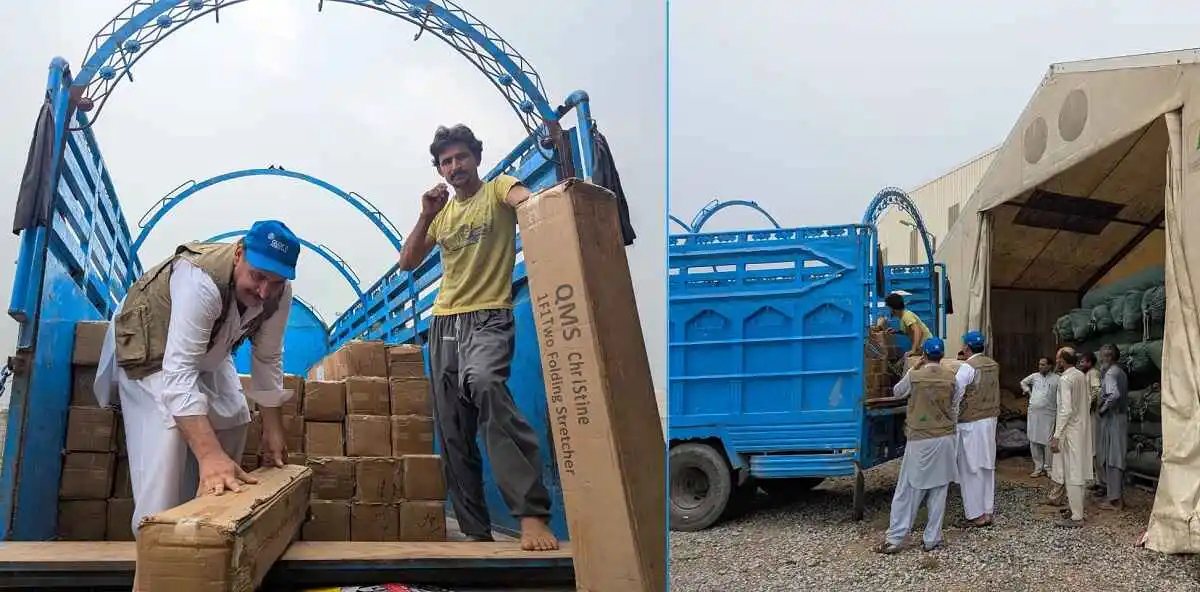Pakistan is reeling from catastrophic floods in 2025, with heavy rains and flash floods claiming hundreds of lives, displacing thousands, and obliterating critical infrastructure. As communities in Khyber Pakhtunkhwa (KP) and beyond grapple with loss and destruction, the United Nations Development Programme (UNDP) has mobilized urgent relief efforts, delivering essential supplies like tents, stretchers, and floodlights to the hardest-hit areas.
With climate-induced disasters intensifying—Pakistan faced $14.9 billion in damages from 2022 floods alone—the stakes are higher than ever. This crisis tests not only local response systems but also the global community’s ability to support vulnerable nations.
A Humanitarian Emergency in Pakistan
The 2025 monsoon season has unleashed unprecedented devastation across Pakistan, particularly in KP’s Nowshera district. Hundreds have perished, thousands of families are displaced, and vital infrastructure—roads, bridges, and homes—lies in ruins. Overcrowded relief camps face shortages of healthcare, clean water, and sanitation, while ongoing rains hinder access to remote areas, leaving stranded communities in dire need. The Provincial Disaster Management Authority (PDMA) estimates over 50,000 people are affected in KP alone, with economic losses potentially reaching billions.
The human toll is staggering. Families who lost everything are sheltering in makeshift camps, vulnerable to disease outbreaks like cholera, which spiked post-2022 floods (WHO data). As X user @PakRelief tweeted, “Entire villages wiped out in KP—where’s the global attention?” The crisis echoes Pakistan’s 2022 floods, which displaced 8 million and killed 1,700, highlighting the growing threat of climate-driven disasters.
UNDP’s Response:
In coordination with PDMA and KP’s Planning and Development Department, UNDP has swiftly delivered critical supplies to Nowshera, including:
- 180 tents for shelter
- 103 stretchers and 53 first aid kits for medical support
- 230 sleeping bags and 130 floodlights for safety and visibility
These items, dispatched on August 19, 2025, target immediate needs, with PDMA overseeing distribution to prioritize the most vulnerable. Ms. Van Nguyen, UNDP Pakistan’s Officer-in-Charge, emphasized a dual approach: “We’re bridging immediate humanitarian gaps while laying the groundwork for longer-term recovery and resilience.”
UNDP’s efforts build on its post-2022 flood work, where it restored 1.2 million homes and supported 4 million people with livelihood programs. Current assessments are underway to scale up aid, focusing on clean water and sanitation to curb health risks in camps.
Climate Crisis Meets Humanitarian Urgency
Unlike past flood narratives centered on immediate relief, this crisis underscores Pakistan’s vulnerability to climate change, ranking 8th on the Global Climate Risk Index despite contributing less than 1% of global emissions. The 2025 floods, driven by intensified monsoons, highlight a systemic challenge: developing nations face disproportionate impacts while global funding lags. UNDP’s response blends emergency aid with a forward-looking push for resilient infrastructure, like flood-resistant housing and early-warning systems, piloted in Sindh post-2022.
This angle also spotlight’s Pakistan’s call for global accountability. At COP29, Pakistan demanded $100 billion annually in climate finance for vulnerable nations, a plea echoed by UNDP’s advocacy for “stronger, safer” rebuilding. X user @ClimatePak noted, “UNDP’s aid is a start, but rich nations need to pay up for climate justice.”
Local Fallout
- Economic Strain: Preliminary estimates suggest $5-10 billion in damages, crippling agriculture (30% of KP’s GDP) and infrastructure. Rebuilding could take years, straining Pakistan’s $350 billion economy.
- Health Risks: Overcrowded camps risk outbreaks, with 2022’s malaria surge (1.6 million cases) a grim precedent. UNDP’s first aid kits and sanitation focus aim to mitigate this.
- Displacement Crisis: Thousands in temporary shelters face long-term displacement, with women and children most vulnerable, per UNICEF reports.
Global Implications
- Climate Finance Pressure: Pakistan’s crisis amplifies calls for Loss and Damage funds, with UNDP’s work spotlighting the need for $400 billion annually by 2030 (UN estimates).
- Diplomatic Push: Pakistan may leverage the crisis to rally Global South support at UN forums, strengthening BRICS ties against Western inaction.
- Humanitarian Precedent: UNDP’s dual focus on relief and resilience could model future responses in climate-vulnerable regions like Bangladesh or Somalia.
Challenges
Ongoing rains pose logistical hurdles, with 20% of KP’s roads impassable (PDMA data). Scaling up aid requires global donors, but only $200 million of the $1 billion pledged post-2022 has been delivered. UNDP’s commitment to resilience—potentially rebuilding 500,000 homes by 2027—offers hope, but success hinges on funding and coordination.
For Pakistan, the floods are a clarion call to bolster climate defenses. For the world, they’re a reminder of shared responsibility. As Ms. Nguyen stated, “Our hearts go out to the families who have lost loved ones, homes, and livelihoods.” Act now: support relief efforts and advocate for climate action.
